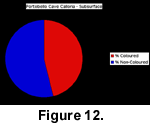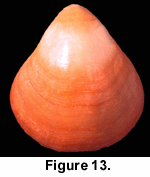COLOUR SURVIVAL IN A
PRESENT-DAY POPULATION
At the present day brachiopods are not common in
inter-tidal habitats, but Calloria inconspicua is found in a few very
shallow water localities around New Zealand. The colouration of living and
subfossil specimens of one of these intertidal populations has been studied to
investigate the pattern of colour decay. Although the Portobello locality
differs in some respects from that inferred for the Wanganui Basin fossils, it
does provide a rare and invaluable opportunity to investigate brachiopod colour
survival in an enclosed shallow water environment.
Large numbers of living Calloria have been
recorded from the Otago Peninsula on the South Island of New Zealand. One
important locality close to the Portobello Marine Laboratory is in a long,
narrow cave excavated in volcanic rocks. This cave has a prominent lip at the
seaward entrance, which restricts access to the open sea and indeed isolates the
cave at low tides. Calloria inconspicua is abundant in this cave, living
at the base of a sloping rock wall and on boulders scattered on the floor of the
cave. Significant numbers of these brachiopods are exposed at low tide, although
the great majority occurs at and below low tide level. While not directly
comparable to the soft-sediment coastline of the Wanganui Basin, the water
depths…
In life, most of the cave brachiopods are situated
in cryptic habitats out of direct sunlight or are covered by encrusting
organisms. However, dead specimens fall onto the cave floor, which is exposed to
direct sunlight at the mouth of the cave. The sediment of the cave floor is a
very fine-grained greenish silt that is easily disturbed. To investigate the
colour survival of dead specimens of Calloria inconspicua, all
individuals (either complete specimens or separated dorsal or ventral valves)
visible on a 2 m2 section of the cave floor
were carefully collected using a snorkel and mask at low tide. This surface collection yielded a total of 281 specimens of which 57% displayed
colouration. The upper layers of the sediment were then bulk sampled and sieved
to a depth of approximately 50 mm using a 2-mm sieve, and the resulting sample
of an additional 321 Calloria shells contained only 46% of individuals
with discernible colouration (Figures 11,
12).
This surface collection yielded a total of 281 specimens of which 57% displayed
colouration. The upper layers of the sediment were then bulk sampled and sieved
to a depth of approximately 50 mm using a 2-mm sieve, and the resulting sample
of an additional 321 Calloria shells contained only 46% of individuals
with discernible colouration (Figures 11,
12).
 In
the interest of conservation of this remarkable locality it was not possible to
harvest and sample the living population, but an underwater survey of
approximately 100 specimens living attached to the cave wall suggested that at
least 95% had strong colouration (Figure 13).
A survey of specimens living in the open sea close to the mouth of the cave
indicated that virtually all shells displayed strong red colouration, although
assessing colouration in living specimens is problematic because of the
prevalence of encrusting organisms.
In
the interest of conservation of this remarkable locality it was not possible to
harvest and sample the living population, but an underwater survey of
approximately 100 specimens living attached to the cave wall suggested that at
least 95% had strong colouration (Figure 13).
A survey of specimens living in the open sea close to the mouth of the cave
indicated that virtually all shells displayed strong red colouration, although
assessing colouration in living specimens is problematic because of the
prevalence of encrusting organisms.
Sedimentation rates in the cave are likely to be
low, and the shells exposed at the surface do become exposed to full sunlight.
However these results confirm that brachiopods tend to lose their shell
colouration when exposed at sediment surfaces. This decay continues after burial
to the extent that more than 50% of the specimens in the top 50 mm of sediment
lose their colour. The fact that around 80% of the fossil specimens of Calloria
inconspicua displayed some traces of colour after 80 ka, as compared with
less than 50% in the top 50 mm of sediment in the Portobello cave, confirms that
the taphonomic conditions at the former locality are unusual.
There is no doubt that the majority of fossil
brachiopods lose whatever colour they may have possessed. Virtually nothing is
known about the length of time over which brachiopod shell colouration will
disappear. Specimens of Calloria inconspicua exposed to daylight for five
years show no obvious signs of colour decay. It seems probable that the timing
of colour decay will vary depending on taphonomic conditions, and that other
factors, such as the nature and effect of percolating groundwater, will also
have an effect. Calloria inconspicua itself occurs extensively throughout
the Wanganui Basin in 35 horizons ranging in age from approximately 2.98 Ma to
40 ka (see the "Interrograte
the Wanganui Database" web site), but
this is the first record of any fossil representatives displaying original shell
colouration from the Basin. Extensive field investigation of many localities in
the Wanganui Basin has failed to reveal any other coloured representatives of Calloria
inconspicua, and specimens from the 40 ka locality do not display any colour.
It seems likely that rapid burial, presumably associated with the resultant
exclusion of light and oxygen, are at least factors in colour survival in the
fossil record. Rapid burial is a realistic inference for the fossil Calloria
shells in any beach gravel deposited on a marine terrace that is likely to have
been formed rapidly in unconsolidated sediments.

 This surface collection yielded a total of 281 specimens of which 57% displayed
colouration. The upper layers of the sediment were then bulk sampled and sieved
to a depth of approximately 50 mm using a 2-mm sieve, and the resulting sample
of an additional 321 Calloria shells contained only 46% of individuals
with discernible colouration (Figures 11,
12).
This surface collection yielded a total of 281 specimens of which 57% displayed
colouration. The upper layers of the sediment were then bulk sampled and sieved
to a depth of approximately 50 mm using a 2-mm sieve, and the resulting sample
of an additional 321 Calloria shells contained only 46% of individuals
with discernible colouration (Figures 11,
12).